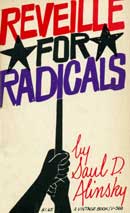

|
|

Reveille for Radicals
Alinksy, Saul D.
Publisher: Vintage, New York, USAYear First Published: {12564 Reveille for Radicals REVEILLE FOR RADICALS Alinksy, Saul D. Vintage New York USA Alinksy connects his theoretical notions on radicalism to practical movements and events. 1946 1969 237pp $1.65 BC12564-ReveilleRadicals.jpg B Book 394-70568-8 Alinsky writes about radical thinkers in the United States. He advocates equality, peace and democracy. In his book he describes radical thought and applies it to his views on various political issues. Critiques of other political activists are also provided. Calling for the middle-class to form coalitions with minority groups, Alinsky pursues social ideals that will create a free and open society. <br> <br>The second edition features a new Introduction and Afterword in which Alinsky reflects on his writing over twenty years later. He connects his theoretical notions on radical thought to his opinions on modern events. There are two parts to Reveille for Radicals, "Call Me Rebel" and "The Building of People's Organizations". Part 1 attempts to define what a rebel is and introduces Alinksy's radical thought. Part 2 discusses how organizations can become powerful and achieve their ends, and also asserts that these organizations must represent the wishes of a group of people, not just one or two leaders. <br> <br>The goal is to encourage active participation in social change, and to work out a people's program that will benefit society. Alinksy introduces a practical methodology that can be used to execute such a program. <br> <br>The book is critical and revolutionary. In eleven chapters, Alinsky introduces radicalism, the problems that radical thinking can overcome, the power of people's organizations, and his vision for the future. He expands his past thinking in this new edition to encompass the political events of the 1960s. According to him, the ultimate goal is the development of overall understanding and critical thinking. Once individuals have improved themselves in this way, they will be ready to create social change. <br> <br>[Abstract by Mia Manns] <br> <br> <br>Table of Contents <br> <br>Introduction to the Vintage Edition <br>Part I Call Me Rebel <br>1 What Is a Radical? <br>2 Where Is the Radical Today? <br>3 The Crisis <br> <br>Part II The Building of People's Organizations <br>4 The Program <br>5 Native Leadership <br>6 Community Traditions and Organizations <br>7 Organizational Tactics <br>8 Conflict Tactics <br>9 Popular Education <br>10 Psychological Observations on Mass Organization <br>11 Reveille for Radicals <br> <br>Afterword to the Vintage Edition CX6704 0 true true false CX6704.htm [0xc0007783f0 0xc0001679e0 0xc000e52d20 0xc000e617d0 0xc000e70b10 0xc000bf7980 0xc000217f50 0xc000b443c0 0xc000f66fc0 0xc001ba4150 0xc000a61da0] Cx} Year Published: 1969 Pages: 237pp Price: $1.65 ISBN: 394-70568-8 Resource Type: Book Cx Number: CX6704 Alinksy connects his theoretical notions on radicalism to practical movements and events. Abstract: Alinsky writes about radical thinkers in the United States. He advocates equality, peace and democracy. In his book he describes radical thought and applies it to his views on various political issues. Critiques of other political activists are also provided. Calling for the middle-class to form coalitions with minority groups, Alinsky pursues social ideals that will create a free and open society. The second edition features a new Introduction and Afterword in which Alinsky reflects on his writing over twenty years later. He connects his theoretical notions on radical thought to his opinions on modern events. There are two parts to Reveille for Radicals, "Call Me Rebel" and "The Building of People's Organizations". Part 1 attempts to define what a rebel is and introduces Alinksy's radical thought. Part 2 discusses how organizations can become powerful and achieve their ends, and also asserts that these organizations must represent the wishes of a group of people, not just one or two leaders. The goal is to encourage active participation in social change, and to work out a people's program that will benefit society. Alinksy introduces a practical methodology that can be used to execute such a program. The book is critical and revolutionary. In eleven chapters, Alinsky introduces radicalism, the problems that radical thinking can overcome, the power of people's organizations, and his vision for the future. He expands his past thinking in this new edition to encompass the political events of the 1960s. According to him, the ultimate goal is the development of overall understanding and critical thinking. Once individuals have improved themselves in this way, they will be ready to create social change. [Abstract by Mia Manns] Table of Contents Introduction to the Vintage Edition Part I Call Me Rebel 1 What Is a Radical? 2 Where Is the Radical Today? 3 The Crisis Part II The Building of People's Organizations 4 The Program 5 Native Leadership 6 Community Traditions and Organizations 7 Organizational Tactics 8 Conflict Tactics 9 Popular Education 10 Psychological Observations on Mass Organization 11 Reveille for Radicals Afterword to the Vintage Edition Subject Headings |